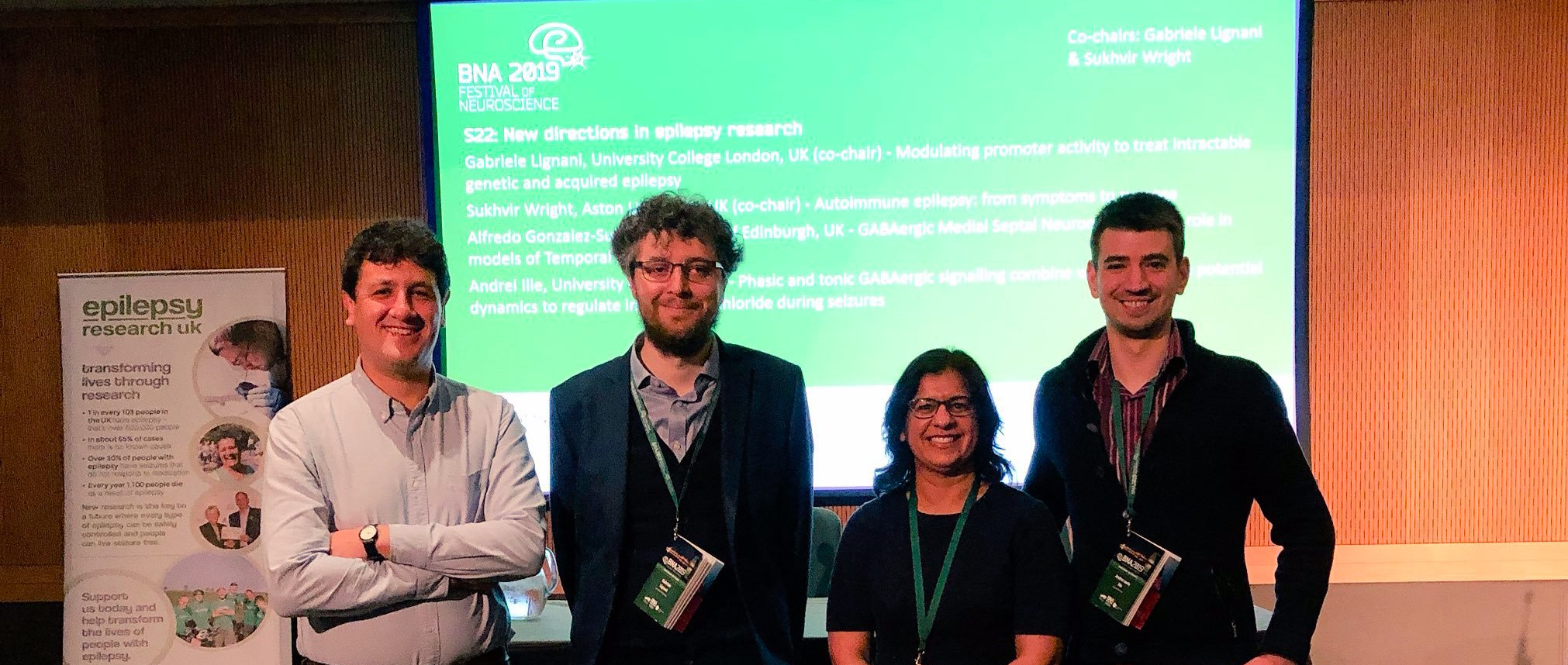
We at Epilepsy in English were lucky enough to attend the British Neuroscience Association’s ‘Festival of Neuroscience’ in Dublin. It was a great opportunity to learn what is happening in the neuroscience field in the UK and Ireland. Amongst other excellent lectures and seminars, one of our personal highlights was the epilepsy-dedicated session ‘New Directions in Epilepsy Research’. This event was organised by Epilepsy Research UK and featured talks from four extremely talented early career researchers.
Here we give a plain English snapshot into four researchers and projects to watch out for in the future.
Gabriele Lignani (University College London) – Modulating promoter activity to treat intractable genetic and acquired epilepsy
The Lignani Lab’s main focus is developing new and more refined gene therapies for epilepsy. One limitation of gene therapy strategies so far is that the genes are permanently ‘switched on’. This means that the therapy has the potential to disrupt normal brain activity, as well as seizures. Gabriele’s lab uses a modified tool with a specific ‘promoter’ – an element within the gene therapy package, which can turn genes on and off. This promoter is highly active during seizures and works at lower levels the rest of the time. When it is switched on, it delivers genetic information to cells to make them less active. So, they have a therapy which is only activated by seizures and is then switched off during normal brain activity. Early results suggest that this treatment reduces the development of epilepsy in animal models.
Sukhvir Wright (Aston University) – Autoimmune epilepsy: from symptoms to synapse
Autoimmunity is where a patient’s own immune system attacks particular proteins in their body. If this protein influences brain activity in some way, the loss of the protein could lead to seizures. Sukhvir’s work took immune components (antibodies) from patients with autoimmune epilepsy and administered them to rodents, to explore their role in seizure generation. She focused on autoimmunity against two brain proteins relevant for seizure activity. First, the NMDA receptor. This protein typically promotes brain excitability, so we might think that losing some can make the brain less excitable and so have fewer seizures. Whilst she did see a reduction in some measures of excitability, these antibodies still made the brain more susceptible to seizures. Second, the GABAA receptor. This is one of the key reducers of brain activity and indeed antibodies against it led to seizures. The promising finding is that, in both cases, the increased seizures could be suppressed by treatment with neurosteroids. This suggests a possible future treatment route for autoimmune epilepsy.
Alfredo Gonzalez-Sulser (University of Edinburgh) – GABAergic Medial Septal Neurones and their role in models of Temporal Lobe Epilepsy
Alfredo’s research looks to disrupt seizure activity by hijacking an existing brain circuit. Seizures are quite often generated in a part of the brain called the hippocampus, when it becomes too electrically active. ‘GABAergic medial septal neurones’ may sound like a mouthful, but they are basically a group of brain cells which target the hippocampus and reduce its activity. The normal function of this circuit is to force cells in the hippocampus to activate repeatedly at a certain rate, all at the same time. This is thought to have a role in how we remember things. Alfredo’s work uses flashes of light – a technology called optogenetics –to be able to control these ‘medial septal neurones’. In this way, he can activate the medial septal neurones when a seizure starts. In turn, they target the hippocampus and reduce the electrical activity of its cells. Alfredo has shown in rodent epilepsy models that this can effectively stop seizures from developing.
Andrei Ilie (University of Oxford) – Phasic and tonic GABAergic signalling combine with membrane potential dynamics to regulate intracellular chloride during seizures
Andrei’s work looks at the role of chloride in seizures. When the brain is functioning normally, concentrated pools of chloride sit outside of brain cells. When certain channels in the cell are opened, typically by a chemical called GABA, the chloride comes rushing in to cells and reduces their electrical activity. During seizures, huge amounts of chloride can enter cells, in an attempt to reduce their activity. Eventually, this system can become saturated and chloride loses its effect or, worse, actually makes cell even more active. Andrei’s work explores how the effect of chloride changes during seizures. Further, he looks at how different types of GABA-controlled channel can have different roles in seizures. He found that targeting only a specific sub-type of channel can protect against seizures.
Overall, we think that these four talks showed a variety of new and exciting findings towards further understanding epilepsy and the possibility of generating novel treatment approaches, painting a highly promising picture for the future.
The BNA Festival of Neuroscience also featured a talk from our very own Cristina Reschke, as part of Neuroscience Ireland’s ‘Precision therapy: Antisense oligonucleotides targeting coding and non-coding RNAs for neurological disorders’ – something which you will be able to read more about in future posts.

Amazing research for epilepsy. My gd has Dravet so I am always interested in what research is out there. Biochemistry is my subject which came in handy when she got the dx and Na channels fascinated me thoughout my studies.
Thanks for your comment Sharon. It’s always great to see how research can make a real difference in people’s lives.